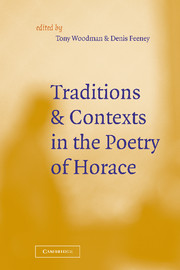Book contents
- Frontmatter
- Contents
- List of contributors
- Prologue
- Acknowledgements
- 1 HORACE'S BIRTHDAY AND DEATHDAY
- 2 AMICVS CERTVS IN RE INCERTA CERNITVR: Epode I
- 3 DREAMING ABOUT QUIRINUS: Horace's Satires and the development of Augustan poetry
- 4 BIFORMIS VATES: the Odes, Catullus and Greek lyric
- 5 THE ODES: just where do you draw the line?
- 6 A WINE-JAR FOR MESSALLA: Carmina 3.21
- 7 FEMININE ENDINGS, LYRIC SEDUCTIONS
- 8 THE UNIQUENESS OF THE CARMEN SAECVLARE AND ITS TRADITION
- 9 SOLVS SAPIENS LIBER EST: recommissioning lyric in Epistles 1
- 10 POETRY, PHILOSOPHY, POLITICS AND PLAY: Epistles 1
- 11 HORACE, CICERO AND AUGUSTUS, OR THE POET STATESMAN AT EPISTLES 2.1.256
- 12 VNA CVM SCRIPTORE MEO: poetry, Principate and the traditions of literary history in the Epistle to Augustus
- 13 EPILOGUE
- Notes
- Abbreviations and bibliography
- Indexes
4 - BIFORMIS VATES: the Odes, Catullus and Greek lyric
Published online by Cambridge University Press: 22 September 2009
- Frontmatter
- Contents
- List of contributors
- Prologue
- Acknowledgements
- 1 HORACE'S BIRTHDAY AND DEATHDAY
- 2 AMICVS CERTVS IN RE INCERTA CERNITVR: Epode I
- 3 DREAMING ABOUT QUIRINUS: Horace's Satires and the development of Augustan poetry
- 4 BIFORMIS VATES: the Odes, Catullus and Greek lyric
- 5 THE ODES: just where do you draw the line?
- 6 A WINE-JAR FOR MESSALLA: Carmina 3.21
- 7 FEMININE ENDINGS, LYRIC SEDUCTIONS
- 8 THE UNIQUENESS OF THE CARMEN SAECVLARE AND ITS TRADITION
- 9 SOLVS SAPIENS LIBER EST: recommissioning lyric in Epistles 1
- 10 POETRY, PHILOSOPHY, POLITICS AND PLAY: Epistles 1
- 11 HORACE, CICERO AND AUGUSTUS, OR THE POET STATESMAN AT EPISTLES 2.1.256
- 12 VNA CVM SCRIPTORE MEO: poetry, Principate and the traditions of literary history in the Epistle to Augustus
- 13 EPILOGUE
- Notes
- Abbreviations and bibliography
- Indexes
Summary
From the epilogue to the first three books of Odes it is clear that Horace saw his principal lyric achievement in terms of Aeolium carmen (3.30.13). The commentators on this passage, if they say anything at all, explain that the reference is to Sappho and Alcaeus. Horace uses a similar phrase, Lesboum … barbiton, in the very first ode of the collection (1.1.34), but here the commentators are divided in their explanation. The majority of those writing in the nineteenth and twentieth centuries, including (most recently) Quinn and West, refer likewise to Sappho and Alcaeus; but in the major commentaries of Kiessling–Heinze and Nisbet–Hubbard reference is made only to Alcaeus. This division of opinion is reflected in the statements of distinguished Horatian scholars which are enshrined in successive editions of the Oxford Classical Dictionary. Writing in 1970, Williams said that ‘Horace claims the early Greek lyric poets, Sappho and Alcaeus, as his model’, whereas according to Syndikus, writing in 1996, ‘Horace declares that his main literary model in the Odes was the early Greek lyric poetry from Lesbos, especially that of Alcaeus.’ What seems to be at issue is the degree to which, or even the question whether, Sappho is important for Horace in his Odes.
It may be pertinent that the word barbitos, used by Horace at the end of his first ode, is not found in the extant remains of Alcaeus and was associated particularly with Sappho.
- Type
- Chapter
- Information
- Traditions and Contexts in the Poetry of Horace , pp. 53 - 64Publisher: Cambridge University PressPrint publication year: 2002
- 12
- Cited by



